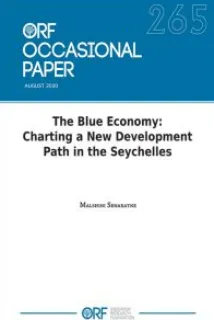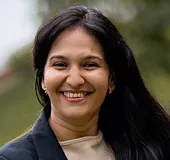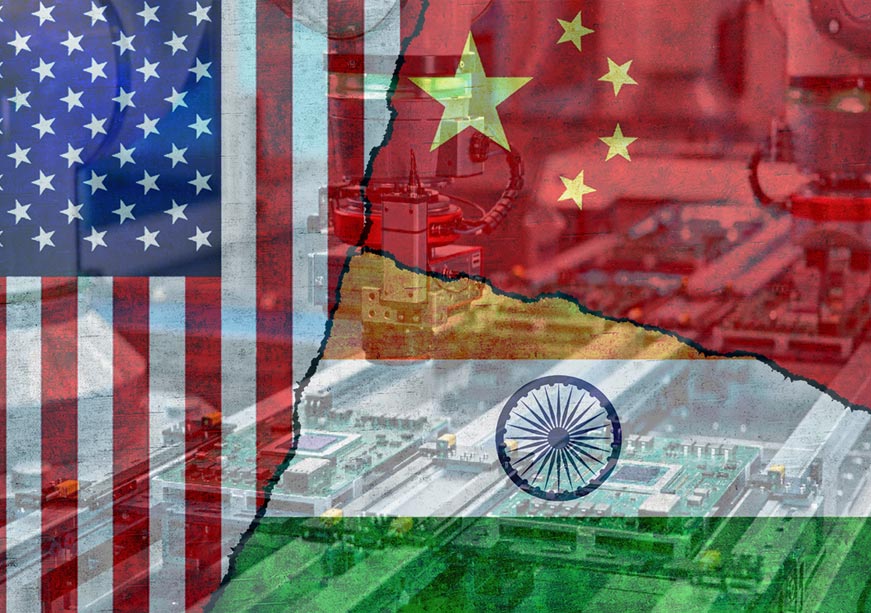[1] National Bureau of Statistics, Government of Seychelles, “Visitor Arrival Statistics December 2019,” Statistical Bulletin.
[2] African Development Bank Group Countries, “Seychelles Economic Outlook,” African Development Bank.
[3] “Board Approves over $20 million for Seychelles’ Sustainable Fisheries and Marine Resources Conservation,” World Bank, September 29, 2017.
[4] “The World Bank in Seychelles,” World Bank, https://www.worldbank.org/en/country/seychelles/overview
[5] Ibid
[6] National Bureau of Statistics, Government of Seychelles, “Seychelles in Figures 2019”.
[7] Ministry of Tourism, Civil Aviation, Ports and Marine, Government of Seychelles, “Seychelles Tourism Master Plan”,
[8] Ibid
[9] “Blue Economy Concept Paper,” United Nations Department of Economic and Social Affairs.
[10] Simone Smith-Godfrey, “Defining the Blue Economy,” Maritime Affairs: Journal of the National Maritime Foundation of India 12, no. 1 (2016).
[11] “What is the Blue Economy?,” World Bank, June 6, 2017.
[12] “What is the Blue Economy?,” European Commission, June 6, 2020.
[13] “Blue Economy,” The Commonwealth, June 6, 2020.
[14] Ki-Hoon Lee, Junsung Noh, and Jong Seong Khim, “The Blue Economy and the United Nations’ sustainable development goals: Challenges and opportunities,” Environment International 137, (2020),
[15] The Ministry of Finance, Trade and the Blue Economy, Government of Seychelles, “The Blue Economy Progress on the Development of the Blue Economy in Seychelles session,”
[16] Jean-Paul Adam, “Harnessing the Blue Economy; the Potential of Seychelles’ Petroleum Sector,” Speech for the East Africa Oil and Gas Summit Nairobi, June 11, 2014.
[17] Mohan Munasinghe, “The sustainomics transdisciplinary meta-framework for making development more sustainable: applications to energy issues,” International Journal of Sustainable Development 5, no. 1/2 (2002).
[18] Ibid
[19] Ibid
[20] “Seychelles Blue Economy Strategic Roadmap and Implementation”, The Commonwealth Secretariat.
[21] Hanna J. Christ, Rachel White, Lincoln Hood, Gabriel M. S. Vianna and Dirk Zeller, “A Baseline for the Blue Economy: Catch and Effort History in the Republic of Seychelles’ Domestic Fisheries,” Frontiers in Marine Science 269, no. 7 (2020).
[22] “Blue Finance”, Development Bank of Seychelles.
[23] “Alternative Future Visions for the Seychelles Blue Economy Background Document,” Meeting of Senior Officials and Commonwealth Advisers.
[24] Ibid
[25] Ministry of Environment, Energy and Climate Change, Government of Seychelles, “Coastal Livelihoods in the Republic of Seychelles”.
[26] Patsy Athanase, “How many tourists are too many? Seychelles commissions a study,” Seychelles News Agency, February 18, 2019, Tourism Section.
[27] Ibid
[28] “Seychelles: Economic challenges may erode development gains”, UN Office for the Coordination of Humanitarian Affairs.
[29] “Staff Report for the 2019 Article IV Consultation and Third Review Under the Policy Coordination Instrument and Request for Modification of Targets and Monetary Consultation Clause for Seychelles,” The International Monetary Fund.
[30] Daniel Laurence, “Seychelles facing economic challenges from climate change, official says,” Seychelles News Agency, November 23, 2018, Environment Section.
[31] Vidya Gappy, “Seychelles’ blue economy action plan validated,” The Seychelles Nation, November 28, 2019, Blue Economy Section.
[32] Andrew Wright, “Seychelles leads the way with first ‘blue bond’ to finance adaptation,” Global Centre on Adaptation, https://gca.org/solutions/seychelles-leads-the-way-with-first-blue-bond-to-finance-adaptation
[33] “Seychelles Blue Economy Strategic Roadmap and Implementation,” The Commonwealth, http://thecommonwealth.org/project/seychelles-blue-economy-strategic-roadmap-and-implementation
[34] “The Blue Economy and the United Nations’ sustainable development goals: Challenges and opportunities”
[35] Carmen Lau, “The Contribution of Sustainable Tourism and Blue Economy towards SDGs – The Case of Seychelles,” Elevate, December 19, 2018,
https://www.elevatelimited.com/insights/the-contribution-of-sustainable-tourism-and-blue-economy-towards-sdgs-the-case-of-seychelles/
[36] Steven R. Elliott, “Sustainability: an economic perspective,” Science Direct: Resources, Conservation and Recycling 44, no. 3 (2005)
http://www.sciencedirect.com/science/article/pii/S0921344905000248
[37] Ministry of Finance, Trade and the Blue Economy, Government of Seychelles, “The Blue Economy Progress on the Development of the Blue Economy in Seychelles“.
[38]Nicholas Nhede, Seychelles kickstarts Africa’s first floating solar pv project.
[39] Sharon Ernesta, “New company negotiating to explore for oil in Seychelles’ waters,” The Seychelles News Agency, March 01 2018, Environment Section.
[40] Ministry of Finance, Trade, Investment and Economic Planning, Government of Seychelles, “Seychelles Vision 2033,”
[41] Salifa Karapetyan, “African Development Bank grant to support small and medium Blue Economy enterprises in Seychelles,” The Seychelles News Agency, April 03, 2020, National Section.
[42]Coëtivy,” Island Development Company Seychelles, https://www.idcseychelles.com/coetivy.html
[43] Phoebe Sleet, “Seychelles to Restart Aquaculture Industry,” Future Directions International, 2018.
[44] Sharon Ernesta, “Aquaculture facility opening in August will ensure strong fish supplies year-round in Seychelles,” The Seychelles News Agency, January 15, 2018, Fisheries Section.
[45] Abhishek Mishra, “Championing Africa’s blue economy agenda: The Seychelles way,” Observer Research Foundation, September 10, 2019
https://www.orfonline.org/expert-speak/championing-africas-blue-economy-agenda-the-seychelles-way-55297/
[46] Sharon Ernesta, “Seychellois military participating in 8th edition of US-led maritime exercise Cutlass Express,” The Seychelles News Agency, January 31, 2019, National News Section,
[47] Africa Defense Forum, “Africa’s Smallest Nation Is Setting a Standard for Safe, Sustainable Seas,” Africa Defense Forum Magazine, January 29, 2019
https://adf-magazine.com/security-the-seychelles-way/.
[48] The Seychelles National Climate Change Committee, Government of Seychelles, “Seychelles National Climate Strategy,”
https://www.preventionweb.net/files/20091100_seychelles_climate_change_strategy_2009.pdf.
[49] Ibid
[50] “The Indian Ocean Trade Hub,” Seychelles Business Feature
https://seychelles.the-report.com/trade-seychelles/
[51] Salifa Karapetyan, “Emirates flight lands in Seychelles carrying first new tourist arrivals since March,” The Seychelles News Agency, August 01, 2020,
[52] Ibid
[53] State House, “Establishment of the Blue Economy Council and the Blue Economy High Level Multi-Stakeholders Forum,” State House News, 30 September, 2019.
[54] Ministry of Finance, Government of Seychelles, “Seychelles National Development Strategy”.
[55] “2018 Annual Report,” Development Bank of Seychelles,
http://www.dbs.sc/sites/default/files/downloads/Annual%20Report%202018.pdf
[56] Kanika Saigal, “Conservation finance: Seychelles’ troubled waters,” EuroMoney, 10 October, 2019, https://www.euromoney.com/article/b1hhzxrs8z0syh/conservation-finance-seychelles39-troubled-waters?copyrightInfo=true
[57] “Dive into the Blue Economy,” James Michel Foundation,
http://www.jamesmichelfoundation.org/
[58] “Deep-sea expedition in Seychelles’ waters to launch Tuesday,” The Seychelles News Agency, March 17, 2020.
[59] Patsy Athanase, “Seychelles Maritime Academy renews agreement with Sri Lanka Nautical College,” The Seychelles News Agency, January 16, 2020, National News Section,
[60] Ministry of Tourism, Civil Aviation, Ports and Marine – Tourism Department, Government of Seychelles, “The Seychelles Tourism Academy and the Shannon College of Hotel Management chart course for future cooperation,”
http://tourism.gov.sc/2018/03/28/the-seychelles-tourism-academy-and-the-shannon-college-of-hotel-management-chart-course-for-future-cooperation/
[61] Seychelles Tourism Academy’s Internship and Admission Coordinator, email message to author, August 12, 2018
[62] Elsie Pointe, “Three decades of civil society engagement celebrated”, Seychelles Nation, November 09, 2019,
http://www.nation.sc//articles/2305/three-decades-of-civil-society-engagement-celebrated
[63] Nature Seychelles, “Blue Economy,”
http://natureseychelles.org/what-we-do/blue-economy
[64] “Projects,” SWIOTUNA, https://www.swiotuna.org/our-projects/
[65] State House, “President Faure meets with the Board of CEPS,” State House News, September 19, 2019.
http://www.statehouse.gov.sc/news/4593/president-faure-meets-with-the-board-of-ceps
[66] “Ceps members learns about the blue economy and extractive initiative,” Seychelles Nation, September 25, 2017, Archives Section, http://www.nation.sc/archive/255803/ceps-members-learn-about-the-blue-economy-and-extractive-initiative
[67] Daniel Laurence, “Seychelles protects 30 percent of territorial waters, meeting target 10 years ahead of schedule”, The Seychelles News Agency, March 26, 2020
[68] “New Report Focuses On Building A Resilient Blue Economy In The Face Of Climate Change,” Secretariat of the Pacific Regional Environment Programme,
https://www.sprep.org/news/new-report-focuses-on-building-a-resilient-blue-economy-in-the-face-of-climate-change
[69] “Seychelles Blue Economy, ” Global Island Partnership, http://glispa.org/commitments/11-commitments/208-seychelles-blue-economy
[70] Ibid
[71] Sharon Ernesta, “8 ways Seychelles has been recognised for its dedication to the environment, Blue Economy,” The Seychelles News Agency, March 17, 2020, Entertainment Section.
[72] State House, “President Faure receives Ocean Heritage Award,” State House News, 09 July 2019, http://www.statehouse.gov.sc/news/4506/president-faure-receives-ocean-heritage-award
[73] State House, “Secretary of State Patrick Payet wins Best Sustainable Finance Solution Award at the 2019 Adam Smith Awards”, State House News, 21 June 2019
[74] State House, “President Danny Faure receives the Blue Economy Award on African Maritime Sectors”, State House News, 28 November, 2018
[75] Sharon Ernesta, “Beginning of a cleaner Seychelles? Ban on plastic bags, plates, cups now in effect in Seychelles,” The Seychelles News Agency, July 04, 2017, Environment section.
[76] “Covid-19 has led to a pandemic of plastic pollution”, The Economist, 22 Jun 2020,
https://www.economist.com/international/2020/06/22/covid-19-has-led-to-a-pandemic-of-plastic-pollution
[77] James Brooks, “Seychelles leader: No time for ‘blame game’ in climate fight”, Associated Press for ABC News, 29 October, 2019,
https://abcnews.go.com/Technology/wireStory/seychelles-leader-time-blame-game-climate-fight-66601817
[78] Sharon Ernesta, “$200,000 fund for environment management part of new EU-Seychelles fisheries agreement,” The Seychelles News Agency, June 17, 2020, Business section.
[79] “The Oceans Economy: Opportunities and Challenges for Small Island Developing States,” United Nations Conference on Trade and Development and the Commonwealth Secretariat,
https://unctad.org/en/PublicationsLibrary/ditcted2014d5_en.pdf,
[80] Bettymie Bonnelame, “New shipping, air routes being explored between India and Seychelles,” The Seychelles News Agency, March 2, 2020, National News section.
[81] “The Fish-I Task Force,” FISH-I Africa,
https://panorama.solutions/sites/default/files/FISH-i_Task_Force_-_Flyer.pdf
[82] Elsie Pointe, “Impact of COVID-19 in Seychelles”, Seychelles Nation, March 17, 2020
http://www.nation.sc/articles/3929/impact-of-covid-19-in-seychelles
[83] Steven Gaines, Reniel Cabral, Christopher M. Free and Yimnang Golbuu, “The Expected Impacts of Climate Change on the Ocean Economy,” World Resources Institute,
www.oceanpanel.org/ expected-impacts-climate-change-ocean-economy
[84] The Seychelles National Climate Change Committee, Government of Seychelles, “Seychelles National Climate Change Strategy,” https://www.preventionweb.net/files/20091100_seychelles_climate_change_strategy_2009.pdf.
[85] Ibid
[86] Malshini Senaratne, “COVID-19, Blue Economy, and the Climate Change Agenda: The Case of Seychelles,” ORF Issue Brief No. 360, (2020), https://www.orfonline.org/research/covid-19-blue-economy-and-the-climate-change-agenda-66279/
[87] “Covid-19 Local Situation,” Department of Health, http://www.health.gov.sc/
[88] “New COVID-19 cases detected on board Spanish fishing vessel”, Department of Health,
http://www.health.gov.sc/index.php/2020/07/08/new-covid-19-cases-detected-on-board-spanish-fishing-vessel/
[89] State House, “Faure chairs Virtual Commonwealth Leaders Meeting,”
http://www.statehouse.gov.sc/news/4883/president-faure-chairs-virtual-commonwealth-leaders-meeting
State House News, June 24, 2020
[90] Sharon Ernesta, “Global action required to counter COVID’s economic toll, Seychelles’ president tells Commonwealth leaders,” The Seychelles News Agency, June 26, 2020, National News section.
[91] Sharon Ernesta, “10 million African Development Bank loan to support opening of Seychelles’ economy,” The Seychelles News Agency, June 25, 2020, National News section.
[92] Ibid
[93] National Bureau of Statistics, Government of Seychelles, “A poverty profile of the Republic of Seychelles,” Statistical Publication, https://www.nbs.gov.sc/files/Poverty-Profile-for-Seychelles.pdf
[94] “Inequalities in Human Development in the 21st Century,” The United Nations Development Programme,
http://hdr.undp.org/sites/all/themes/hdr_theme/country-notes/SYC.pdf
[95] Ibid
[96] “The Seychelles National Food and Nutrition Security Policy,” Government of Seychelles,
http://www.mofa.gov.sc/downloads/seychelles-national-food-nutrition-security-policy.pdf
[97] Daniel Laurence, “Seychelles seeks to improve food production, rely less on imports,” The Seychelles News Agency, August 31, 2017, National News section.
[98] Pawan G. Patil John Virdin Charles S. Colgan M.G. Hussain Pierre Failler and Tibor Vegh, “Toward a Blue Economy: A Pathway for Sustainable Growth in Bangladesh”, The World Bank Group https://www.middlebury.edu/institute/sites/www.middlebury.edu.institute/files/2018-11/11.2.18.Blue%20Economy-Bangladesh%20Final%20Paper_0.pdf,
[99] Nilanjan Ghosh, “Ecological Economics: Sustainability, Markets, and Global Change,” In Global Change, Ecosystems, Sustainability: Theory, Methods, Practice, eds. Pranab Mukhopadhyay, Nandan Nawn, Kalyan Das (Sage Publishers, 2017), 11-25.
[100] Mia Pantzar and Marianne Kettunen, “A Sustainable Blue Economy – Adopting the concept of ecosystem services in EU marine protected area,” Institute for European Environmental Policy, February 12, 2018
https://ieep.eu/publications/a-sustainable-blue-economy-adopting-the-concept-of-ecosystem-services-in-eu-marine-protected-area,
[101] Ibid
[102] Kanika Saigal, “Conservation finance: Seychelles’ troubled waters,” EuroMoney, 10 October, 2019, https://www.euromoney.com/article/b1hhzxrs8z0syh/conservation-finance-seychelles39-troubled-waters?copyrightInfo=true
[103] Lindsey Johnstone, “Watch: Traditional fishing at odds with Seychelles ‘blue economy’,”
Euronews with Associated Press, March 25, 2019 https://www.euronews.com/2019/03/25/watch-traditional-fishing-at-odds-with-seychelles-blue-economy,
[104] Daniel Laurence, “Indian Ocean fishermen gather in Seychelles, discuss climate change, Blue Economy,” The Seychelles News Agency, September 12, 2019, Business section,
[105] Nicolas Delaunay, “Addiction in paradise: Seychelles battles heroin crisis,” Medical Express, February 20, 2020
https://medicalxpress.com/news/2020-02-addiction-paradise-seychelles-heroin-crisis.html,
[106] Malshini Senaratne and Andrew Zimbroff, “The Blue Economy in the Indian Ocean – A Literature Review,” Seychelles Research Journal 121, no. 2 (2019),
https://seychellesresearchjournalcom.files.wordpress.com/2019/08/the-blue-economy-in-the-indian-ocean-a-literature-review-malshini-senaratne-andrew-zimbroff.pdf
[107] Nilanjan Ghosh, “How women can change the world,” Observer Research Foundation, March 16, 2020
https://www.orfonline.org/research/how-women-can-change-world-63378/
[108] “The price tag of violence against women and girls,” The Commonwealth Secretariat, September 26, 2018, https://thecommonwealth.org/media/news/ask-expert-price-tag-violence-against-women-and-girls
[109] Sharon Ernesta, “After increase in gender-based violence, Seychelles pushes for action plan”, The Seychelles News Agency, February 25, 2019, National News section, http://www.seychellesnewsagency.com/articles/10472/After+increase+in+gender-based+violence%2C+Seychelles+pushes+for+action+plan
[110] United Nations Environment Programme, Regional State of the Coast Report: Western Indian Ocean (New York: United Nations, 2016), 445, Google Books,
https://books.google.sc/books/about/Regional_State_of_the_Coast_Report.html?id=tibGDwAAQBAJ&redir_esc=y
[111] Ministry of Finance, Trade, Investment and Economic Planning, Government of Seychelles, “Seychelles Vision 2033,” http://www.finance.gov.sc/uploads/files/Vision_2033.pdf
[112] Seychelles Fisheries Sector, Government of Seychelles, “Seychelles Fisheries Sector Policy and Strategy 2019,” http://www.mofa.gov.sc/downloads/Seychelles%20Fisheries%20Sector%20Policy%20.pdf
[113] Natalie Parletta, “Making the Blue Economy a sustainable reality,” Forbes, June 21, 2019
https://www.forbes.com/sites/natalieparletta/2019/06/21/making-the-blue-economy-a-sustainable-reality/#5d2ab04526f8
[114] Mauritian Ministry of Blue Economy, Marine Resources, Fisheries and Shipping, Government of Mauritius, “About Us,” http://blueconomy.govmu.org/English/Pages/default.aspx.
[115] Ibid
[116] Rachel Cooper, “Civil society and its role and value in 2018”.
[117] Open Government Partnership Seychelles Action Plan 2019-2021, Government of Seychelles, “Public Participation in the Budget,” https://www.opengovpartnership.org/members/seychelles/commitments/SYC0001/
[118] The Blue Economy and Climate change in the Context of Sustainable Development, Government of Seychelles, “Seychelles National Report”.
[119] Nirmal Shah, “The Blue Economy needs R&D,” Environment in Seychelles, November 08, 2013, https://environmentinseychelles.com/2013/11/08/blue-economy-needs-rd/
[120] Daniel Etongo, Vincent Amelie, Angelique Pouponneau and Walter Leal Filho, “Identifying and Overcoming Barriers to Climate Change Adaptation in the Seychelles,” In African Handbook of Climate Change Adaptation, eds. Leal Filho W., Ogugu N., Adelake L., Ayal D., da Silva I. (Springer Nature Switzerland, 2020), 2-17. and
Gregory Andrusz and Libby Cooper, “Youth Unemployment in Seychelles”, https://unisey.ac.sc/wp-content/uploads/Report-on-Youth-Unemployment-in-Seychelles-1.pdf
[121] National Bureau of Statistics, Government of Seychelles, “Quarterly Unemployment Statistics-Youth Special Edition,” Statistical Publication,
https://www.nbs.gov.sc/downloads/youth-qlfs-q4-2019/viewdocument
[122] Georgina Beresford, “Marine Scholarship Program: Investing in today’s youth by choosing a blue career for a sustainable future,” Presented during the webinar “Innovation for a Sustainable Ocean,” Mahe, Seychelles, 09 June 2020.
[123] Erika Techera, “Achieving Blue Economy goals: The need for improved legal frameworks across the Indian Ocean,” Seychelles Research Journal 5, no. 2 (2019),
https://seychellesresearchjournalcom.files.wordpress.com/2019/08/achieving-blue-economy-goals-erika-techera.pdf
[124] “COVID collateral damage: 53 Seychellois students must defer overseas study to 2021,” The Seychelles News Agency, June 22, 2020.
[125] Ibid
[126] Elsie Pointe, “Blue Economy Advocates meet Vice President,” The Seychelles Nation, May 26, 2020, Blue Economy section, http://www.nation.sc/articles/4776/blue-economy-advocates-meet-vice-president-meriton
[127] “Seychelles reforms its maritime sector to capitalize on Blue Economy,” Nature Seychelles Blue Economy Knowledge Centre, http://blueeconomyseychelles.org/seychelles-reforms-maritime-sector
[128] Sharon Ernesta, “Hotel shutdowns in Seychelles straining Public Utilities Corporation’s bottom line,” The Seychelles News Agency, July 01, 2020, National News section.
[129] Jean-Paul Adam, “Building Back Better through the Blue Economy,” Presented during the webinar “Ocean Optimism and looking ahead: Shark Conservation and Building the Blue Economy post-COVID-19,” Mahe, Seychelles, 1 May 2020.
[130] Ibid
[131] Shimul Bijoor, “Mainstreaming blue carbon to finance coastal resilience,” Green Biz, February 12, 2020,
https://www.greenbiz.com/article/mainstreaming-blue-carbon-finance-coastal-resilience
[132] “Reflections from the perspective of Belize, CARICOM and SIDS,” The Blue Economy and Climate change in the Context of Sustainable Development,
https://europa.eu/capacity4dev/file/32263/download?token=dwqUjl2X
[133] Sebastian Thomas, “Blue carbon: Knowledge gaps, critical issues, and novel approaches,” Ecological Economics, 107, no. 2 (2014),
https://www.sciencedirect.com/science/article/abs/pii/S0921800914002304
[134] Ibid
[135] Seychelles Conservation and Climate Adaptation Trust, “Roadmap to Blue Carbon opportunities in the Seychelles,” SEYCCAT,
https://seyccat.org/roadmap-to-blue-carbon-opportunities-in-the-seychelles/ and
“The James Michel Foundation carries out first Blue Carbon study for Seychelles” Seychelles Nation, February 01, 2020,
http://www.nation.sc/articles/3312/the-james-michel-foundation-carries-out-first-blue-carbon-study-for-seychelles
[136] Marleen S. Schutter and Christina C. Hicks, “Networking the Blue Economy in Seychelles: pioneers, resistance, and the power of influence,” Journal of Political Ecology 26, no. 1 (2019),
https://journals.uair.arizona.edu/index.php/JPE/article/view/23102/22226
[137] Salifa Karapetyan, “Private sector, government should work together to advance blue economy, Seychelles’ VP says”, The Seychelles News Agency, February 22, 2018, National News section.
[138] Seychelles Conservation and Climate Adaptation Trust, “Should We Sacrifice Innovative Financing for the Blue Economy during the Global Pandemic?”, SEYCCAT,
https://seyccat.org/should-we-sacrifice-innovative-financing-for-the-blue-economy-during-the-global-pandemic/
[139] Benjamin S. Halpern et al, “Trade-offs and triple–bottom-line solutions,” Proceedings of the National Academy of Sciences of the United States of America 110, no. 15 (2013),
https://www.pnas.org/content/early/2013/03/19/1217689110.abstract?sid=964670aa-0fa9-4142-86b0-2de4f78a9358.
[140] “2020 presidential election,” Seychelles Nation, June 06, 2020, Domestic Section.
[141] “Blue Economy,” Nature Seychelles.

 PDF Download
PDF Download



 PREV
PREV


